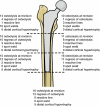Large femoral bone loss after hip revision using the uncemented proximally porous-coated Bi-Metric prosthesis: 22 hips followed for a mean of 6 years
- PMID: 19234883
- PMCID: PMC2823225
- DOI: 10.1080/17453670902804802
Large femoral bone loss after hip revision using the uncemented proximally porous-coated Bi-Metric prosthesis: 22 hips followed for a mean of 6 years
Abstract
Background and purpose: Periprosthetic bone loss after uncemented femoral hip revision is a matter of concern. We have used a proximally porous- and hydroxyapatite-coated prosthesis (Bi-Metric) in revision since 1989 and now we report the bone changes. This prosthesis is intended to distribute the forces more evenly and to avoid proximal femoral unloading.
Methods: 22 patients were unilaterally reoperated because of aseptic loosening. Only patients with a healthy contralateral hip were included. Mean age at revision was 69 (55-80) years. Bone defects were graded by Gustilo-Pasternak and Endo-Klinik classifications. Clinical assessment was performed with Harris hip score. We used radiographs and dual-energy X-ray absorptiometry to evaluate migration, femoral remodeling, and bone mineral density after 72 (30-158) months.
Results: The mean Harris hip score was 74 (30-100) points at follow-up. Mild thigh discomfort was present in 1 patient and moderate thigh pain in 3 patients. There was no loosening or subsidence. Osteolysis seen at revision had diminished in 19 of the 22 hips at follow-up. We noted a large reduction in bone mineral density. It was most pronounced in Gruen regions 1, 2, 6, and 7.
Interpretation: Revision with this stem is a reliable procedure; however, we noted a large degree of proximal bone loss that could lead to later mechanical complications or fractures.
Figures



References
-
- Aldinger PR, Thomsen M, Mau H, Ewerbeck V, Breusch SJ. Cementless Spotorno tapered titanium stems. Excellent 10-15-year survival in 141 young patients. Acta Orthop Scand. 2003;74(3):253–8. - PubMed
-
- Bodén H, Adolphson P. No adverse effects of early weight bearing after uncemented total hip arthroplasty. A randomized study of 20 patients. Acta Orthop Scand. 2004;75(1):21–9. - PubMed
-
- Bodén H, Adolphson P, Öberg M. Unstable versus stable uncemented femoral stems. A radiological study of periprosthetic bone changes in two types of uncemented stems with different concepts of fixation. Arch Orthop Trauma Surg. 2004;124(6):382–92. - PubMed
-
- Bodén H, Salemyr M, Sköldenberg O, Ahl T, Adolphson P. Total hip arthroplasty with an uncemented hydroxyapatite-coated tapered titanium stem: Results at a minimum of 10 years' follow-up in 104 hips. J Orthop Sci. 2006a;11(2):175–9. - PubMed
-
- Bodén HS, Sköldenberg OG, Salemyr MO, Lundberg HJ, Adolphson PY. Continuous bone loss around a tapered uncemented femoral stem. A long-term evaluation with DEXA. Acta Orthop. 2006b;77(6):877–85. - PubMed
Publication types
MeSH terms
Substances
LinkOut - more resources
Full Text Sources
Medical
